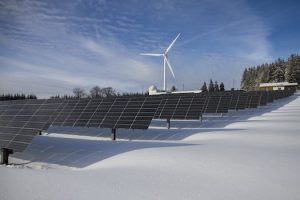
The world is rapidly transitioning to renewable energy sources to meet the growing demand for electricity. This shift is especially important in rural markets, where access to reliable power is often limited. Renewable energy sources such as solar, wind, and hydropower can provide a reliable and cost-effective source of electricity for telecom facilities and connectivity in rural markets. This article will explore the potential of renewable energy for power generation in rural markets, the challenges associated with its implementation, and the benefits it can bring.
The transition to renewable energy sources is not only necessary to meet the growing demand for electricity, but also to reduce greenhouse gas emissions and mitigate climate change. In rural markets, the lack of access to reliable power can have serious consequences for economic development, education, healthcare, and social services. By leveraging renewable energy sources, rural communities can improve their access to modern energy services and bridge the digital divide.
Solar energy is one of the most promising renewable energy sources for rural markets, as it can be easily installed and maintained, and does not require a large upfront investment. Solar panels can be mounted on rooftops or installed on the ground, and can generate electricity even in cloudy or low-light conditions. In addition, solar power systems can be combined with battery storage to provide backup power during blackouts or periods of low sunlight.
Wind energy is another renewable energy source that can be suitable for rural markets, especially in areas with high wind speeds. Wind turbines can be installed on farms, ranches, or other large properties, and can generate electricity for local use or for sale to the grid. However, wind energy systems can be more expensive and complex to install and maintain than solar systems, and may require a larger land area.
Hydropower is a third renewable energy source that can be harnessed in rural areas with access to rivers or streams. Small-scale hydropower systems can be installed to generate electricity for local use, and can also provide irrigation or water supply for agriculture or livestock. However, hydropower systems may require permits and environmental assessments, and may have impacts on fish and wildlife habitats.
Implementing renewable energy systems in rural markets can face several challenges, including limited financing, lack of technical expertise, and inadequate policy frameworks. Governments and development partners can support the adoption of renewable energy by providing financial incentives, technical assistance, and regulatory frameworks that encourage private sector investment and innovation. In addition, community engagement and capacity building can help ensure that renewable energy projects are designed and implemented in a sustainable and inclusive manner.
The benefits of renewable energy for rural markets are numerous and far-reaching. By reducing dependence on fossil fuels and grid electricity, renewable energy can improve energy security and resilience, reduce energy costs, and create local jobs and economic opportunities. Moreover, renewable energy can enable access to modern energy services and connectivity, and contribute to poverty reduction, health, and education outcomes.
In conclusion, the transition to renewable energy sources is essential for meeting the growing energy demand in rural markets, while also addressing the challenges of climate change and energy access. By leveraging the potential of solar, wind, and hydropower, rural communities can improve their quality of life and achieve sustainable development.

Huawei, Comsat, Zte, and Samsung are just a few examples of companies that are constantly striving to put their best foot forward. These companies are known for their innovative products and cutting-edge technology, which are used by millions of people around the world.
Huawei, for instance, is a Chinese multinational technology company that specializes in telecommunications equipment and consumer electronics. The company has been at the forefront of innovation in the tech industry, with its smartphones and other devices featuring advanced features and functionalities that are unmatched by its competitors.
Comsat is another company that is known for its innovation in the tech industry. The company is a leader in the satellite communications industry, providing solutions for military, commercial, and government customers around the world. Its advanced technology and services have helped to revolutionize the way we communicate and access information.
Zte is another Chinese multinational technology company that specializes in telecommunications equipment and consumer electronics. The company is known for its high-quality products and innovative solutions, which have made it a leading player in the tech industry.
Samsung is one of the most well-known companies in the tech industry. They are responsible for some of the most popular and iconic products in the industry, including smartphones, tablets, and laptops. Samsung has a strong focus on innovation and is constantly pushing the boundaries of what is possible in the tech industry.
Overall, these companies are leading the charge when it comes to innovation and technology. By putting their best foot forward and constantly striving to improve, they are shaping the future of the tech industry and changing the way we live, work, and communicate.

Renewable energy sources offer a sustainable solution to the growing demand for electricity in remote and rural areas. As the world continues to grapple with the effects of climate change, it is increasingly important to reduce reliance on non-renewable energy sources such as fossil fuels. Telecom facilities and connectivity in rural markets often face challenges in accessing reliable and affordable sources of electricity. Renewable energy sources such as solar, wind, and hydropower offer a promising solution to this problem.
Solar energy is particularly well-suited for rural markets as it is widely available and can be easily installed in remote areas. In many cases, solar panels can be installed on rooftops or on the ground, making it a flexible solution for a range of different applications. Furthermore, solar energy is a low-maintenance option, which means that once installed, it requires minimal upkeep.
Wind energy is another viable option for rural markets, especially in areas with strong winds. Wind turbines can be installed on land or offshore, depending on the location and the requirements of the telecom facility. Wind energy is also a cost-effective option, as the cost of wind turbines has been declining over the past few years.
Hydropower is another potential source of renewable energy for telecom facilities in rural markets. Hydropower uses the energy of flowing water to generate electricity. It can be used in rivers, streams, or other bodies of water to generate electricity. Hydropower is a reliable and consistent source of energy, as the flow of water can be predicted and controlled.
In conclusion, renewable energy sources such as solar, wind, and hydropower offer a reliable and cost-effective solution for telecom facilities and connectivity in rural markets. These sources of energy are sustainable, low-maintenance, and can be easily installed in remote areas. As the world continues to prioritize sustainability, it is important to invest in renewable energy sources that can provide reliable and affordable electricity to rural communities.

While renewable energy sources have the potential to provide a reliable and cost-effective source of electricity for telecom facilities and connectivity in rural markets, there are several challenges associated with its implementation. One of the biggest challenges is the lack of infrastructure in rural areas. Many rural areas lack the necessary infrastructure to support the installation and maintenance of renewable energy systems. Additionally, the cost of installing and maintaining renewable energy systems can be prohibitively expensive for many rural communities.
Furthermore, there is a lack of awareness and education about the benefits of renewable energy sources in rural areas. This lack of knowledge can result in resistance from rural communities to invest in renewable energy. Additionally, there is a need for policies and regulations that support the development of renewable energy infrastructure in rural areas.
Another challenge is the variability of renewable energy sources. Solar and wind energy, for example, are dependent on weather conditions and may not always be available. This variability can make it difficult to maintain a consistent and reliable source of electricity for telecom facilities in rural areas.
Finally, there is a need for skilled technicians who can install, operate, and maintain renewable energy systems in rural areas. Without trained personnel, rural communities may struggle to keep their renewable energy systems functioning properly.
Overall, while renewable energy sources hold great promise for providing reliable and cost-effective electricity for telecom facilities and connectivity in rural markets, addressing these challenges will be critical to their successful implementation.
Despite the challenges associated with implementing renewable energy in rural markets, there are several benefits that make it an attractive option. One of the biggest benefits is that renewable energy sources are clean and sustainable. Renewable energy sources do not produce any harmful emissions, making them a much more environmentally friendly option than traditional sources of energy. Additionally, renewable energy sources are often cheaper than traditional sources of energy, making them a cost-effective option for rural communities.
Another benefit of renewable energy in rural markets is that it can be used to provide energy to remote areas that are not connected to the main power grid. This is particularly important in developing countries, where many rural communities do not have access to reliable electricity. Renewable energy can be used to power homes, schools, hospitals and other essential facilities, improving living standards and quality of life for rural communities.
Furthermore, renewable energy projects can create job opportunities in rural areas, providing employment for local residents and supporting local economies. This is because renewable energy projects require a range of skills, from engineering and construction to maintenance and operation. In addition, renewable energy projects can stimulate local businesses, such as suppliers of equipment and materials.
Renewable energy can also help to reduce dependence on imported fossil fuels, which can be expensive and subject to price fluctuations. By generating their own energy from renewable sources, rural communities can become more self-sufficient and less vulnerable to external factors that can affect energy prices.
Finally, investing in renewable energy can help to mitigate the impacts of climate change, which is becoming an increasingly pressing issue for rural communities. By reducing greenhouse gas emissions and promoting sustainable development, renewable energy can help to protect natural resources and support resilient communities in the face of environmental challenges.
– The world is transitioning to renewable energy sources to meet the growing demand for electricity
– Renewable energy is especially important in rural markets where access to reliable power is limited
– Solar, wind, and hydropower are promising sources of renewable energy for telecom facilities and connectivity in rural markets
– Challenges of implementing renewable energy in rural markets include lack of infrastructure, cost, lack of awareness, policy and regulatory barriers, variability of renewable energy sources, and lack of skilled technicians
– Benefits of renewable energy in rural markets include sustainability, cost-effectiveness, improved access to electricity, job creation, reduced dependence on fossil fuels, and mitigation of climate change impacts.
Renewable energy sources have the potential to provide a reliable and cost-effective source of electricity for telecom facilities and connectivity in rural markets. While there are several challenges associated with its implementation, the benefits of renewable energy make it an attractive option for rural communities. Renewable energy sources are clean and sustainable, and they can often be cheaper than traditional sources of energy. By investing in renewable energy sources, rural communities can benefit from reliable and cost-effective power generation.
Moreover, renewable energy sources can provide a decentralized source of power, which is particularly important in rural areas where the electricity grid might not be as reliable or accessible. Additionally, renewable energy sources can help reduce carbon emissions and improve air quality, which is crucial for rural areas that rely on agriculture and natural resources. This can lead to better health outcomes and a more sustainable future for rural communities.
However, implementing renewable energy sources in rural areas can also pose challenges. One of the main challenges is the initial cost of investment, which can be relatively high. Additionally, rural areas might not have the necessary infrastructure or expertise to support renewable energy systems, which can lead to higher maintenance costs and longer implementation times. Finally, renewable energy sources might not be as reliable as traditional sources of energy, particularly in areas with limited sunlight or wind.
Despite these challenges, the benefits of renewable energy make it an attractive option for rural communities. By investing in renewable energy, rural communities can benefit from reliable and cost-effective power generation that is clean and sustainable. Additionally, renewable energy can provide new economic opportunities, such as jobs in the renewable energy sector or increased demand for locally produced biofuels. Overall, renewable energy has the potential to transform rural electrification, providing a sustainable and reliable source of electricity for rural communities.
Join the renewable energy movement and invest in a sustainable future for rural communities. By choosing renewable energy, we can benefit from reliable and cost-effective power generation that is clean and sustainable. Let’s create new economic opportunities and transform rural electrification. Together, we can make a positive impact on our environment and our communities. Act now and invest in renewable energy for a brighter future.